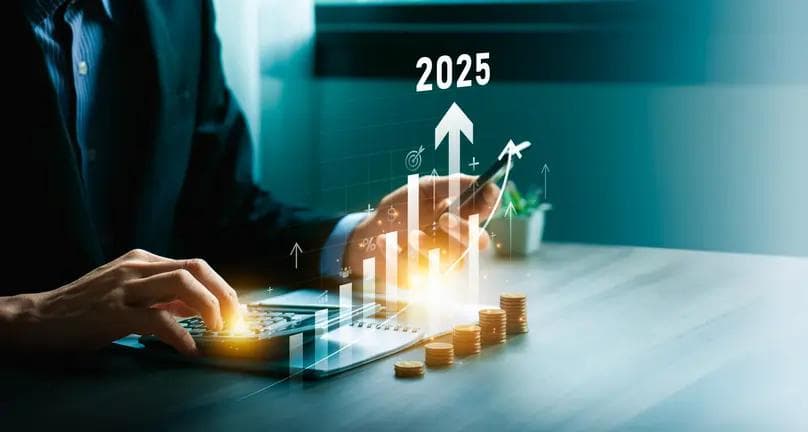Blockchain Technology Trends
Blockchain Technology Trends
Published by Jessica Weisman-Pitts
Posted on February 21, 2025

Published by Jessica Weisman-Pitts
Posted on February 21, 2025

As we step into 2025, blockchain technology continues to redefine the landscape of various industries. From finance to agriculture, the integration of blockchain is not just a trend but a transformative force. This opinion piece delves into the key trends shaping the blockchain ecosystem this year, supported by facts and figures from credible sources.
Institutional Adoption and Regulatory Clarity
One of the most significant developments in the blockchain space is the increased institutional adoption. The U.S. Securities and Exchange Commission (SEC) has established a new Crypto Task Force to develop a comprehensive regulatory framework, signaling a move towards clearer guidelines and increased institutional participation (Brave New Coin). This regulatory clarity is crucial for traditional financial entities, including hedge funds, pension funds, and asset managers, who are increasingly incorporating digital assets into their portfolios.
The establishment of such frameworks not only provides a safety net for investors but also encourages more conservative institutions to explore blockchain technologies. This shift is further supported by the development of tailored institutional products like Binance Wealth, which is redefining how institutions engage with digital assets (YourStory). These products offer a range of services, from custody solutions to bespoke investment strategies, catering to the unique needs of institutional investors.
The approval of spot Bitcoin and Ethereum exchange-traded funds (ETFs) is a testament to this trend, enhancing market liquidity and contributing to greater stability. This institutional expansion is not just a fleeting trend but a foundational shift that could redefine the financial landscape. As more institutions enter the space, we can expect increased innovation and competition, driving further advancements in blockchain technology.
Moreover, the regulatory clarity provided by the SEC and other global regulatory bodies is likely to spur innovation in compliance technologies. Companies are investing in blockchain-based compliance solutions that automate regulatory reporting and ensure adherence to complex financial regulations. This trend not only reduces the burden on financial institutions but also enhances transparency and trust in the blockchain ecosystem.
The Rise of Tokenized Assets
Tokenization is another trend gaining momentum, with the market for tokenized securities expected to grow significantly. Public blockchains are starting to host these assets, making traditional financial tools like stocks, bonds, and real estate more efficient by speeding up settlements and cutting out middlemen (Brave New Coin). This shift towards tokenized assets is not just about efficiency; it's about democratizing access to investment opportunities.
Tokenization allows for fractional ownership, enabling investors to purchase smaller portions of high-value assets. This democratization opens up new avenues for retail investors, who can now access markets that were previously out of reach. Moreover, tokenized assets offer increased liquidity, as they can be traded on secondary markets with ease.
There will be an increased demand for tokenized assets, including equities and fixed income, as traditional Web2 companies adopt blockchain technology (Ava Labs). The conversation around Central Bank Digital Currencies (CBDCs) is advancing, with Binance's partnerships with global players like Circle and AWS positioning it uniquely to support such initiatives (YourStory). The integration of CBDCs with existing blockchain infrastructures could revolutionize how we perceive and use money, offering a seamless bridge between traditional and digital finance.
Furthermore, the tokenization of real-world assets is expected to extend beyond financial instruments to include intellectual property, art, and even personal data. This expansion could lead to new business models and revenue streams, as individuals and organizations find innovative ways to monetize their assets through blockchain technology.
AI and Blockchain: A Powerful Convergence
The convergence of AI and blockchain is another trend to watch. AI is improving trading, market analysis, and managing portfolios, playing a bigger role in decentralized finance (DeFi) by making lending and trading smarter and providing users with better information (Brave New Coin). This integration is not just about enhancing capabilities; it's about creating a more intelligent and responsive financial ecosystem.
AI algorithms can analyze vast amounts of data to identify patterns and trends, providing insights that were previously unattainable. This capability is particularly valuable in DeFi, where real-time data analysis can lead to more informed decision-making and risk management. AI and blockchain together can boost capabilities like AI agents and provenance tracking, maintaining data integrity and making smarter decisions. This trend is set to explode in 2025 (Ava Labs).
The synergy between AI and blockchain also extends to areas like supply chain management, where AI can optimize logistics and blockchain can ensure transparency and traceability. This powerful combination could redefine how we interact with digital assets and data, paving the way for more efficient and secure systems.
In addition, the integration of AI and blockchain is expected to drive advancements in personalized finance. AI-powered robo-advisors can leverage blockchain data to offer tailored investment advice and portfolio management, enhancing the user experience and democratizing access to financial services.
DeFi and Stablecoins: The Future of Finance
Decentralized finance (DeFi) continues to grow, with the total value locked in DeFi protocols expected to climb over $200 billion by the end of 2025 (Brave New Coin). This growth is driven by new decentralized applications (dApps), better user experiences, and more participation from institutions.
DeFi platforms offer a range of financial services, from lending and borrowing to trading and insurance, all without the need for traditional intermediaries. This disintermediation reduces costs and increases accessibility, making financial services available to a broader audience. As DeFi matures, we can expect more sophisticated products and services, catering to both retail and institutional investors.
Stablecoins are also becoming increasingly important in global finance, with daily transactions possibly going over $300 billion. They offer an efficient alternative for international payments, making them a strong contender against traditional systems (Brave New Coin). Stablecoins provide the stability of fiat currencies with the efficiency of blockchain technology, enabling seamless cross-border transactions and reducing reliance on traditional banking systems.
Moreover, the rise of algorithmic stablecoins, which maintain their peg through smart contracts and decentralized mechanisms, is expected to further enhance the stability and resilience of the DeFi ecosystem. These innovations could lead to new financial products and services that are more inclusive and accessible to a global audience.
E-commerce and Payment Solutions
Blockchain-based payment solutions are becoming more common, with businesses like Shopify exploring crypto payment integrations. This shift could make digital asset transactions more mainstream and encourage wider consumer adoption of cryptocurrencies (Brave New Coin). The integration of blockchain in e-commerce is not just a technological advancement; it's a step towards a more decentralized and consumer-friendly marketplace.
Blockchain technology offers several advantages for e-commerce, including reduced transaction fees, faster settlement times, and enhanced security. These benefits can lead to cost savings for merchants and a better shopping experience for consumers. As more businesses adopt blockchain-based payment solutions, we can expect increased competition and innovation in the e-commerce space.
Additionally, the use of blockchain for supply chain transparency and product authentication is gaining traction in the e-commerce industry. Consumers are increasingly demanding information about the origin and authenticity of products, and blockchain provides a secure and immutable record of this data. This trend is likely to drive further adoption of blockchain technology in e-commerce, enhancing trust and accountability in the marketplace.
Explore more articles in the Trends category











